From WWII to Vietnam: A Pilot’s Story
Use controls above or click here to open this Hometown Heroes podcast in a new window
90-year-old Jim Roach of Las Vegas, NV appears on episode #379 of Hometown Heroes, debuting August 8, 2015. A native of Ogden, UT, Roach earned his wings at the age of 19 and flew 15 B-24 bombing missions with the 485th Bomb Group, 830th Squadron during World War II.
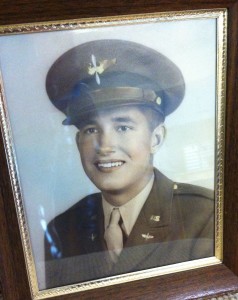
Jim Roach was just 19 years old when he earned his wings. For more photos relating to Jim and his story, visit the Hometown Heroes facebook page.
Listen to the program to hear about Jim’s growing up years in Utah, and how he heard about the Japanese attack on Pearl Harbor. You’ll also hear what caused him to declare, right after graduating high school in 1942, that he was going to become a pilot, and he joined the U.S. Army Air Corps. From his first cockpit experience in a Stearman, he fell in love with flying. CLICK HERE for a video of Jim walking us through the different aircraft he flew during his 30-year Air Force career. While completing his B-24 training at Kirtland Air Force Base in Albuquerque, NM, he was offered the chance to stay in Albuquerque and fly for the bombardier training school there. It would have kept him out of combat for some, if not all, the remainder of the war. Jim didn’t consider that proposition for very long.
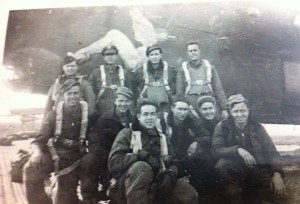
Jim Roach (standing, second from left), and his B-24 crew with the 485th Bomb Group, 830th Squadron.
“No, I want to go to the big dance,”
Jim remembers responding to that offer of stateside service. “I wanted to go fly the B-24 in Europe.” That’s exactly what he would do in late, 1944, heading overseas in charge of a ten-man crew with which he had trained for six months. They were a close knit group that would only grow closer over the months ahead. “Nothing forms camaraderie more quickly and more lastingly than being in combat with people,” you’ll hear Jim explain. Flying out of Venosa, Italy, Roach completed 15 missions before Nazi Germany surrendered. Among the most nerve-wracking were bombing runs aimed at targets in Vienna, Austria, which intelligence reports indicated was protected by a battery of the enemy’s infamous 88mm anti-aircraft guns.
The B-24 was designed for 6,000 feet of runway, but Jim and other B-24 pilots had to try to land on the Yugoslavian island of Vis, where the runway measured a mere 2,200 feet. “It was tight. I knew we didn’t have a lot of room to spare,” he recalls. Among the other B-24 pilots to make an emergency landing on Vis was future presidential candidate George McGovern. Many bombers crashed while trying land on the abbreviated airstrip at Vis. Roach is thankful he was more fortunate, and thankful he made it home from World War II. After being discharged, he met his wife Pat while attending junior college, and went on to earn a degree at Utah State University before returning to the Air Force in 1950. Jim enjoyed stateside duty in California and Maine, among other places, and in the 1960s, deployed to Germany. “They called us the Berlin Lunch Bunch,” he remembers about the clandestine, CIA-connected “spook squadron” for which he served as Operations Officer. Flying an EC-97G outfitted for audio and visual surveillance, he would fly regularly along the edge of East German airspace, and also around the Mediterranean, with electronic warfare officers on board trying to pick up frequencies used by Cold War enemies.
You’ll hear how changing the routine midday takeoff that produced their nickname to an early morning departure led to a signficant discovery. When their covert efforts identified the frequency for a Fan Song radar station operating there, it enabled American forces to divert surface-to-air missiles (SAMs) that had been taking out U.S. planes in Vietnam. “That was a big, big, BIG achievement,” Jim says.
“It saved a lot of fighter pilots’ butts.”
You’ll hear Jim explain why he went from straight from Germany to special duty in Vietnam in 1968, deciding to go to war again instead of an option that would have taken him back to stateside duty. Flying AC-119 Shadow gunships with the 71st and 17th Special Operations Squadrons, Roach flew nighttime interdiction missions, protecting special forces on the ground from oncoming North Vietnamese Army troops. Listen to Hometown Heroes for Jim’s recollection of a dusk-to-dawn mission near the Laotian border that earned him the Distinguished Flying Cross. You’ll also hear about the emotional reunion with his wife and daughter when he returned from his service in Vietnam. Roach retired from the Air Force with the rank of Lieutenant Colonel after 30 years of service. In June of 2015, Jim and Pat celebrated their 66th anniversary. Listen to the interview for what Jim has to say about Pat, as well as his advice for those hoping for a marriage that lasts as long as theirs has.
Thanks to Greg Schoppe, a pilot who marvels at Jim Roach’s aerial exploits, for connecting me to his great uncle, and allowing us all to hear from another World War II veteran who deserves our thanks for his service to our country.
—Paul Loeffler


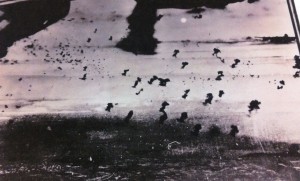
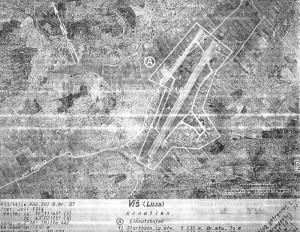
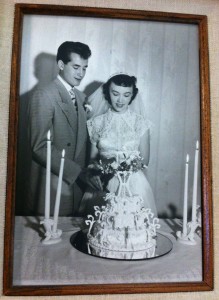
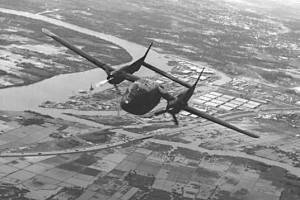
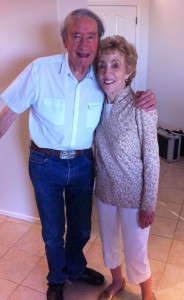
Pingback: URL